Flexible and Multifunctional Composites with Highly Strain Sensing and Impact Resistance Properties
Abstract
1. Introduction
2. Material and Methods
2.1. Materials
2.2. Synthesis of the Ecoflex/Aerogel/Spacer Fabric Composites
2.3. Preparation of the Ecoflex/Aerogel/Spacer Fabric Sensor
2.4. Instruments
3. Results and Discussion
3.1. Characterizations of the Ecoflex/Aerogel/Spacer Fabric Composites
3.2. Static Mechano-Electrical Performance of the Ecoflex/Aerogel/Spacer Fabric Sensor
3.3. The Dynamic Mechano-Electrical Properties and Safeguarding Performance of the Ecoflex/Aerogel/Spacer Fabric Sensor under Impact
3.4. Temperature-Sensing Performance and Thermal Insulation Property of the Ecoflex/Aerogel/Spacer fabric Composites
3.5. Thermal Insulation Property of the Ecoflex/Aerogel/Spacer Fabric Composites
3.6. The Compression and Anti-Imapct Properties of the Ecoflex/Aerogel/Spacer Fabric Composites
4. Conclusions
Supplementary Materials
Author Contributions
Funding
Institutional Review Board Statement
Data Availability Statement
Conflicts of Interest
References
- Gonçalves, C.; Ferreira da Silva, A.; Gomes, J.; Simoes, R. Wearable e-textile technologies: A review on sensors, actuators and control elements. Inventions 2018, 3, 14. [Google Scholar] [CrossRef]
- Luo, N.; Zhang, J.; Ding, X.; Zhou, Z.; Zhang, Q.; Zhang, Y.T.; Chen, S.C.; Hu, J.L.; Zhao, N. Textile-enabled highly reproducible flexible pressure sensors for cardiovascular monitoring. Adv. Mater. Technol. 2018, 3, 1700222. [Google Scholar] [CrossRef]
- Wang, C.; Li, X.; Gao, E.; Jian, M.; Xia, K.; Wang, Q.; Xu, Z.; Ren, T.; Zhang, Y. Carbonized silk fabric for ultrastretchable, highly sensitive, and wearable strain sensors. Adv. Mater. 2016, 28, 6640–6648. [Google Scholar] [CrossRef]
- Chen, X.; An, J.; Cai, G.; Zhang, J.; Chen, W.; Dong, X.; Zhu, L.; Tang, B.; Wang, J.; Wang, X. Environmentally friendly flexible strain sensor from waste cotton fabrics and natural rubber latex. Polymers 2019, 11, 404. [Google Scholar] [CrossRef]
- Park, M.; Lee, K.S.; Shim, J.; Liu, Y.; Lee, C.; Cho, H.; Kim, M.J.; Park, S.-J.; Yun, Y.J.; Kim, H.Y. Environment friendly, transparent nanofiber textiles consolidated with high efficiency PLEDs for wearable electronics. Org. Electron. 2016, 36, 89–96. [Google Scholar] [CrossRef]
- Huang, J.; Li, D.; Zhao, M.; Lv, P.; Lucia, L.; Wei, Q. Highly stretchable and bio-based sensors for sensitive strain detection of angular displacements. Cellulose 2019, 26, 3401–3413. [Google Scholar] [CrossRef]
- Park, S.; Jayaraman, S. Smart textiles: Wearable electronic systems. MRS Bull. 2003, 28, 585–591. [Google Scholar] [CrossRef]
- He, X.; Song, P.; Shen, X.; Sun, Y.; Ji, Z.; Zhou, H.; Li, B. Chitosan-assisted synthesis of wearable textile electrodes for high-performance electrochemical energy storage. Cellulose 2019, 26, 9349–9359. [Google Scholar] [CrossRef]
- Nandy, M.; Liu, S.; Wu, Y.; Yu, H. Fabrication of flexible and stretchable highly conductive Ag-PDMS tri-layer interconnect and its integration into Li-ion pouch cells. In Proceedings of the 2023 IEEE 73rd Electronic Components and Technology Conference (ECTC), Orlando, FL, USA, 30 May–2 June 2023; pp. 450–454. [Google Scholar]
- Yan, C.; Wang, J.; Lee, P.S. Stretchable Graphene Thermistor with Tunable Thermal Index. ACS Nano 2015, 9, 2130–2137. [Google Scholar] [CrossRef] [PubMed]
- Liu, H.; Li, Q.; Zhang, S.; Yin, R.; Liu, X.; He, Y.; Dai, K.; Shan, C.; Guo, J.; Liu, C. Electrically conductive polymer composites for smart flexible strain sensors: A critical review. J. Mater. Chem. C 2018, 6, 12121–12141. [Google Scholar] [CrossRef]
- Ma, S.; Tang, J.; Yan, T.; Pan, Z. Performance of Flexible Strain Sensors with Different Transition Mechanisms: A Review. IEEE Sens. J. 2022, 22, 7475–7498. [Google Scholar] [CrossRef]
- Yan, T.; Wang, Z.; Pan, Z.-J. Flexible strain sensors fabricated using carbon-based nanomaterials: A review. Curr. Opin. Solid State Mater. Sci. 2018, 22, 213–228. [Google Scholar] [CrossRef]
- Wen, J.; Tang, J.; Ning, H.M.; Hu, N.; Zhu, Y.Y.; Gong, Y.K.; Xu, C.H.; Zhao, Q.N.; Jiang, X.P.; Hu, X.L.; et al. Multifunctional Ionic Skin with Sensing, UV-Filtering, Water-Retaining, and Anti-Freezing Capabilities. Adv. Funct. Mater. 2021, 31, 2011176. [Google Scholar] [CrossRef]
- Yin, G.; Hu, N.; Karube, Y.; Liu, Y.L.; Li, Y.; Fukunaga, H. A carbon nanotube/polymer strain sensor with linear and anti-symmetric piezoresistivity. J. Compos. Mater. 2011, 45, 1315–1323. [Google Scholar] [CrossRef]
- Huang, K.Y.; Ning, H.M.; Hu, N.; Liu, F.; Wu, X.P.; Wang, S.; Liu, Y.L.; Zou, R.; Yuan, W.F.; Alamusi; et al. Ultrasensitive MWCNT/PDMS composite strain sensor fabricated by laser ablation process. Compos. Sci. Technol. 2020, 192, 108105. [Google Scholar] [CrossRef]
- Zhang, M.; Wang, C.; Liang, X.; Yin, Z.; Xia, K.; Wang, H.; Jian, M.; Zhang, Y. Weft-Knitted Fabric for a Highly Stretchable and Low-Voltage Wearable Heater. Adv. Electron. Mater. 2017, 3, 1700193. [Google Scholar] [CrossRef]
- Wang, S.; Ning, H.M.; Hu, N.; Liu, Y.L.; Liu, F.; Zou, R.; Huang, K.Y.; Wu, X.P.; Weng, S.Y.; Alamusi. Environmentally-Friendly and Multifunctional Graphene-Silk Fabric Strain Sensor for Human-Motion Detection. Adv. Mater. Interfaces 2020, 7, 1901507. [Google Scholar] [CrossRef]
- Jiang, X.P.; Ren, Z.L.; Fu, Y.F.; Liu, Y.F.; Zou, R.; Ji, G.P.; Ning, H.M.; Li, Y.Q.; Wen, J.; Qi, H.J.; et al. Highly Compressible and Sensitive Pressure Sensor under Large Strain Based on 3D Porous Reduced Graphene Oxide Fiber Fabrics in Wide Compression Strains. Acs Appl. Mater. Interfaces 2019, 11, 37051–37059. [Google Scholar] [CrossRef]
- Hu, B.; Hu, N.; Li, Y.; Akagi, K.; Yuan, W.F.; Watanabe, T.; Cai, Y. Multi-scale numerical simulations on piezoresistivity of CNT/polymer nanocomposites. Nanoscale Res. Lett. 2012, 7, 402. [Google Scholar] [CrossRef]
- Ali, I.; Shchegolkov, A.; Shchegolkov, A.; Zemtsova, N.; Bogoslovskiy, V.; Shigabaeva, G.; Galunin, E.; Hussain, I.; Almalki, A.S.A.; Alsharif, M.A. Preparation and application practice of temperature self-regulating flexible polymer electric heaters. Polym. Eng. Sci. 2022, 62, 730–742. [Google Scholar] [CrossRef]
- Zhang, S.; Wang, S.; Wang, Y.; Fan, X.; Ding, L.; Xuan, S.; Gong, X. Conductive Shear Thickening Gel/Polyurethane Sponge: A Flexible Human Motion Detection Sensor with Excellent Safeguarding Performance. Compos. Part A Appl. Sci. Manuf. 2018, 112, 197–206. [Google Scholar] [CrossRef]
- Hong, X.; Zhao, W.; Yu, R.; Wang, Q.; Zeng, F.; Tao, Y.; Jin, Z.; Zhu, C. Multifunctional silver nanowire coated fabric capable of electrothermal, resistance temperature-sensitivity, electromagnetic interference shielding, and strain sensing. J. Ind. Text. 2022, 51, 6153S–6172S. [Google Scholar] [CrossRef]
- Arico, A.S.; Bruce, P.; Scrosati, B.; Tarascon, J.-M.; Van Schalkwijk, W. Nanostructured materials for advanced energy conversion and storage devices. Nat. Mater. 2005, 4, 366–377. [Google Scholar] [CrossRef]
- Guo, Y.G.; Hu, J.S.; Wan, L.J. Nanostructured materials for electrochemical energy conversion and storage devices. Adv. Mater. 2008, 20, 2878–2887. [Google Scholar] [CrossRef]
- Rolison, D.R.; Long, J.W.; Lytle, J.C.; Fischer, A.E.; Rhodes, C.P.; McEvoy, T.M.; Bourg, M.E.; Lubers, A.M. Multifunctional 3D nanoarchitectures for energy storage and conversion. Chem. Soc. Rev. 2009, 38, 226–252. [Google Scholar] [CrossRef] [PubMed]
- Liu, J.; Cao, G.; Yang, Z.; Wang, D.; Dubois, D.; Zhou, X.; Graff, G.L.; Pederson, L.R.; Zhang, J.G. Oriented nanostructures for energy conversion and storage. ChemSusChem 2008, 1, 676–697. [Google Scholar] [CrossRef] [PubMed]
- Jacobson, M.Z. Review of solutions to global warming, air pollution, and energy security. Energy Environ. Sci. 2009, 2, 148–173. [Google Scholar] [CrossRef]
- Dell, R.M.; Rand, D.A.J. Energy storage-a key technology for global energy sustainability. J. Power Sources 2001, 100, 2–17. [Google Scholar] [CrossRef]
- Wang, S.; Ning, H.; Liu, F.; Hu, N.; Zhang, H.; Zou, R.; Wen, J.; Huang, K.; Wu, X.; Song, Z. Wearable Multifunctional Graphene-Based Aerogel/Spacer Fabric Composites for Sensing and Impact Protection. Adv. Mater. Technol. 2022, 7, 2200010. [Google Scholar] [CrossRef]
- Zhu, W. Flexible Piezoresistive Composite Strain Sensors Based on Cellulose Carbon Gels. Master’s Thesis, Chongqing University, ChongQing, China, 2018. [Google Scholar]
- Song, Y.; Chen, H.; Su, Z.; Chen, X.; Miao, L.; Zhang, J.; Cheng, X.; Zhang, H. Highly Compressible Integrated Supercapacitor-Piezoresistance-Sensor System with CNT-PDMS Sponge for Health Monitoring. Small 2017, 13, 1702091. [Google Scholar] [CrossRef]
- Li, Y.Q.; Zhu, W.B.; Yu, X.G.; Huang, P.; Fu, S.Y.; Hu, N.; Liao, K. Multifunctional Wearable Device Based on Flexible and Conductive Carbon Sponge/Polydimethylsiloxane Composite. ACS Appl. Mater. Interfaces 2016, 8, 33189–33196. [Google Scholar] [CrossRef] [PubMed]
- Wu, X.; Han, Y.; Zhang, X.; Zhou, Z.; Lu, C. Large-Area Compliant, Low-Cost, and Versatile Pressure-Sensing Platform Based on Microcrack-Designed Carbon Black@Polyurethane Sponge for Human-Machine Interfacing. Adv. Funct. Mater. 2016, 26, 6246–6256. [Google Scholar] [CrossRef]
- Zhao, B.; Dong, Z.; Cong, H. A wearable and fully-textile capacitive sensor based on flat-knitted spacing fabric for human motions detection. Sens. Actuators A Phys. 2022, 340, 113558. [Google Scholar] [CrossRef]
- Uzun, S.; Seyedin, S.; Stoltzfus, A.L.; Levitt, A.S.; Alhabeb, M.; Anayee, M.; Strobel, C.J.; Razal, J.M.; Dion, G.; Gogotsi, Y. Knittable and Washable Multifunctional MXene-Coated Cellulose Yarns. Adv. Funct. Mater. 2019, 29, 1905015. [Google Scholar] [CrossRef]
- Xu, L.; Huang, Z.; Deng, Z.; Du, Z.; Sun, T.L.; Guo, Z.H.; Yue, K. A Transparent, Highly Stretchable, Solvent-Resistant, Recyclable Multifunctional Ionogel with Underwater Self-Healing and Adhesion for Reliable Strain Sensors. Adv. Mater. 2021, 33, e2105306. [Google Scholar] [CrossRef] [PubMed]
- Li, S.; Dong, K.; Li, R.; Huang, X.; Chen, T.; Xiao, X. Capacitive pressure sensor inlaid a porous dielectric layer of superelastic polydimethylsiloxane in conductive fabrics for detection of human motions. Sens. Actuators A Phys. 2020, 312, 112106. [Google Scholar] [CrossRef]
- Li, Q.; Duan, T.; Shao, J.; Yu, H. Fabrication method for structured porous polydimethylsiloxane (PDMS). J. Mater. Sci. 2018, 53, 11873–11882. [Google Scholar] [CrossRef]
- Ito, J.; Nakamura, J.; Natori, A. Semiconducting nature of the oxygen-adsorbed graphene sheet. J. Appl. Phys. 2008, 103, 113712. [Google Scholar] [CrossRef]
- Boukhvalov, D.W.; Katsnelson, M.I. Modeling of Graphite Oxide. J. Am. Chem. Soc. 2008, 130, 10697–10701. [Google Scholar] [CrossRef]
- Qin, H.; Zhang, Y.; Jiang, J.; Wang, L.; Song, M.; Bi, R.; Zhu, P.; Jiang, F. Multifunctional Superelastic Cellulose Nanofibrils Aerogel by Dual Ice-Templating Assembly. Adv. Funct. Mater. 2021, 31, 2106269. [Google Scholar] [CrossRef]

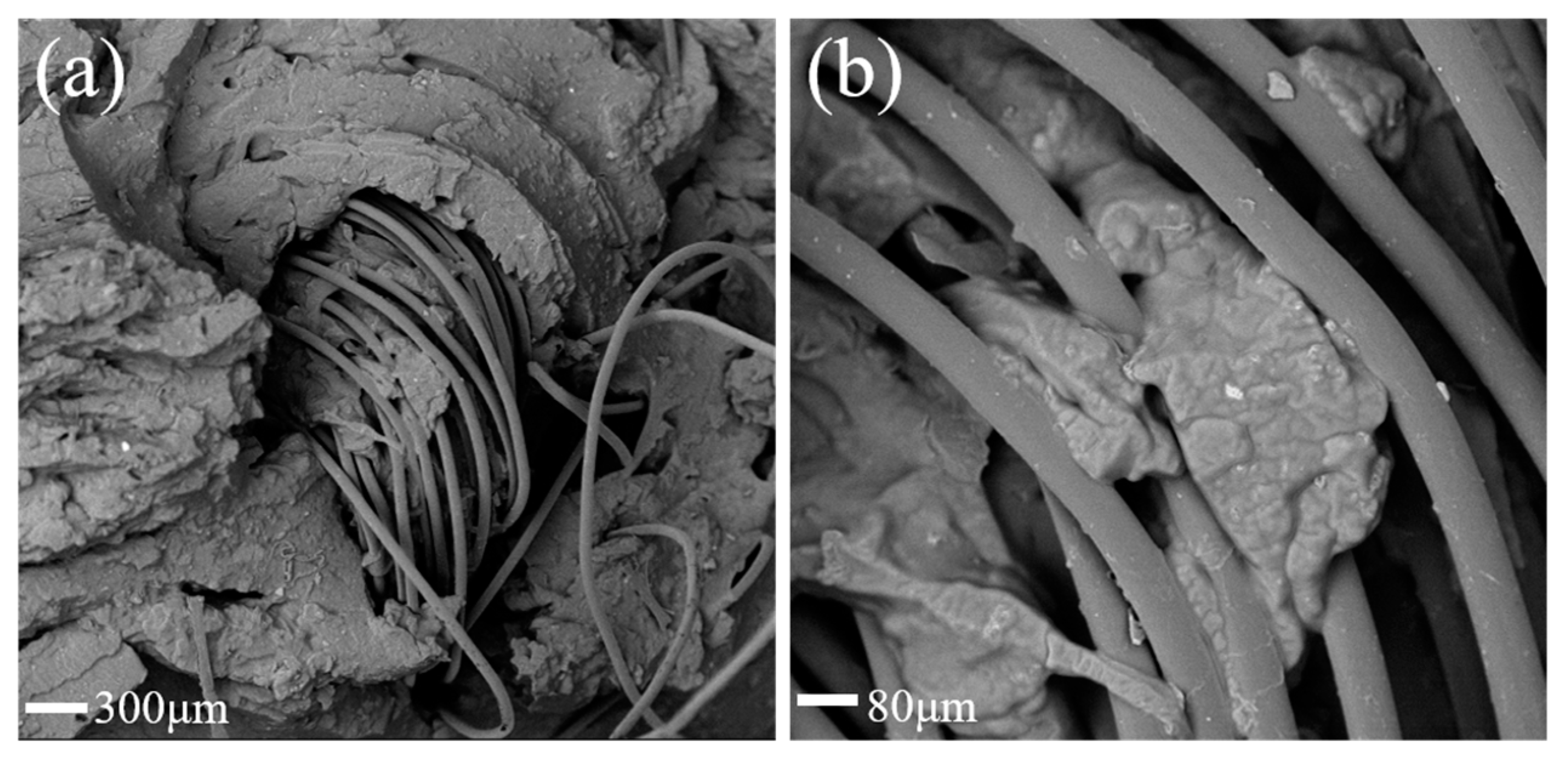
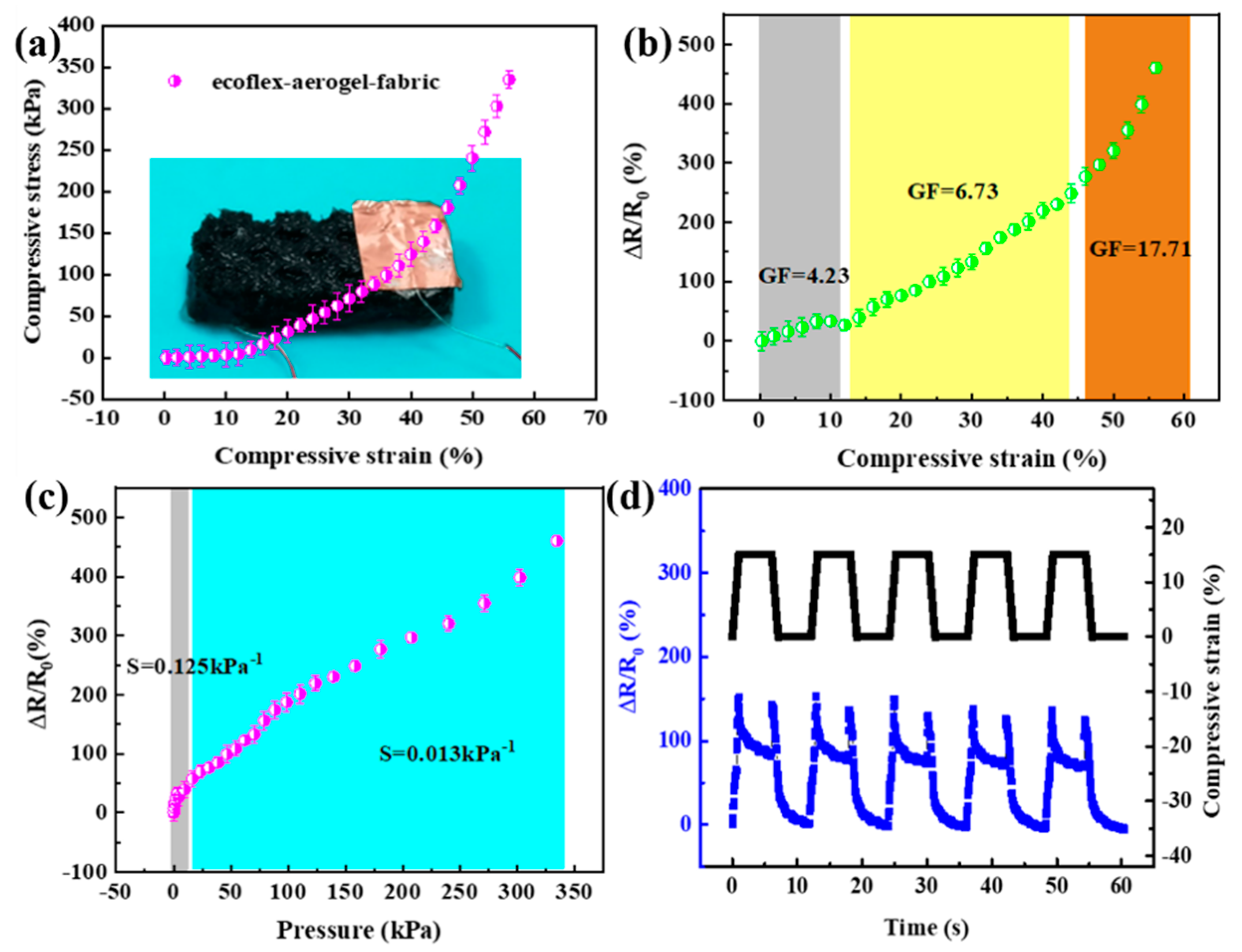

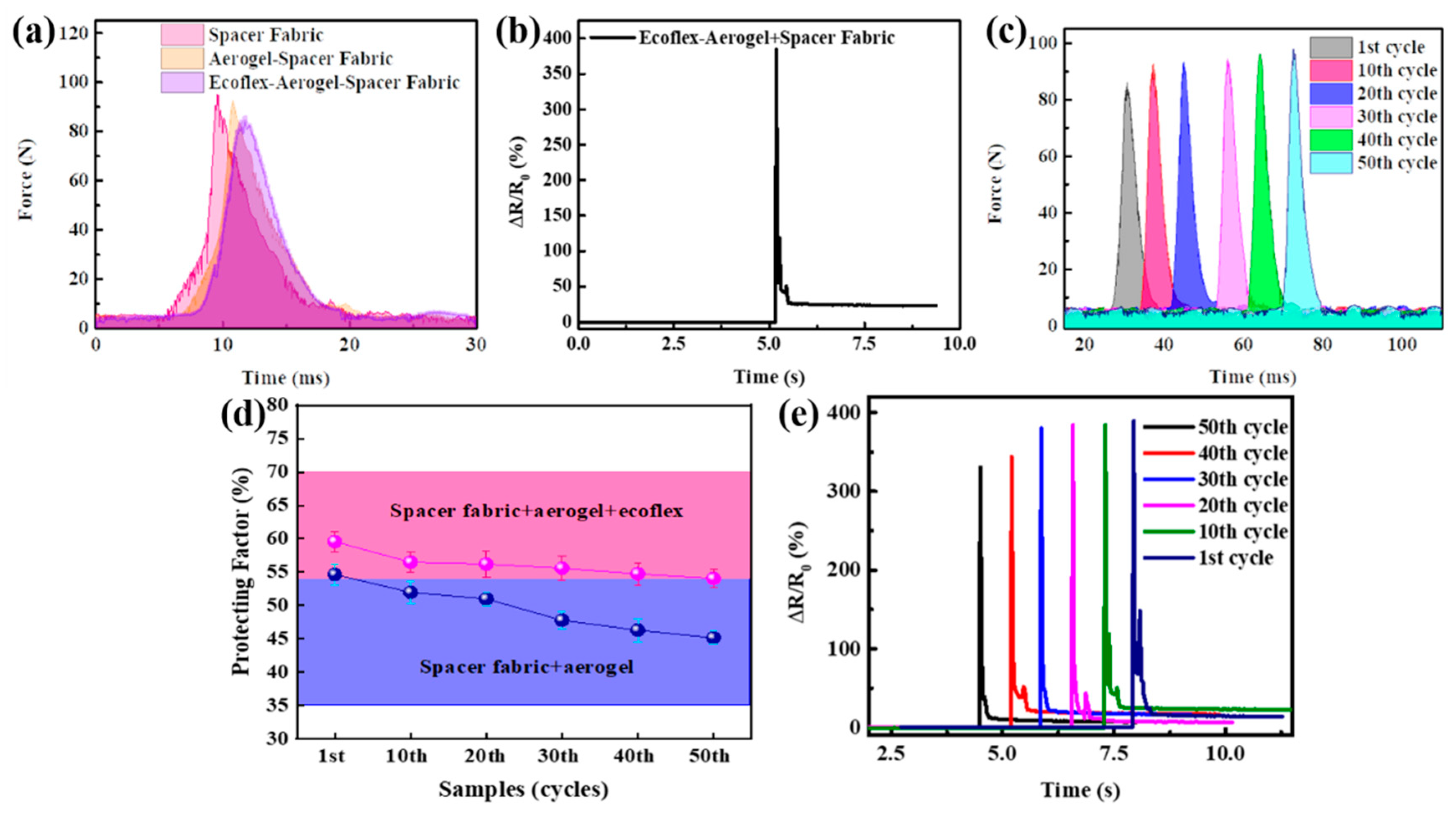
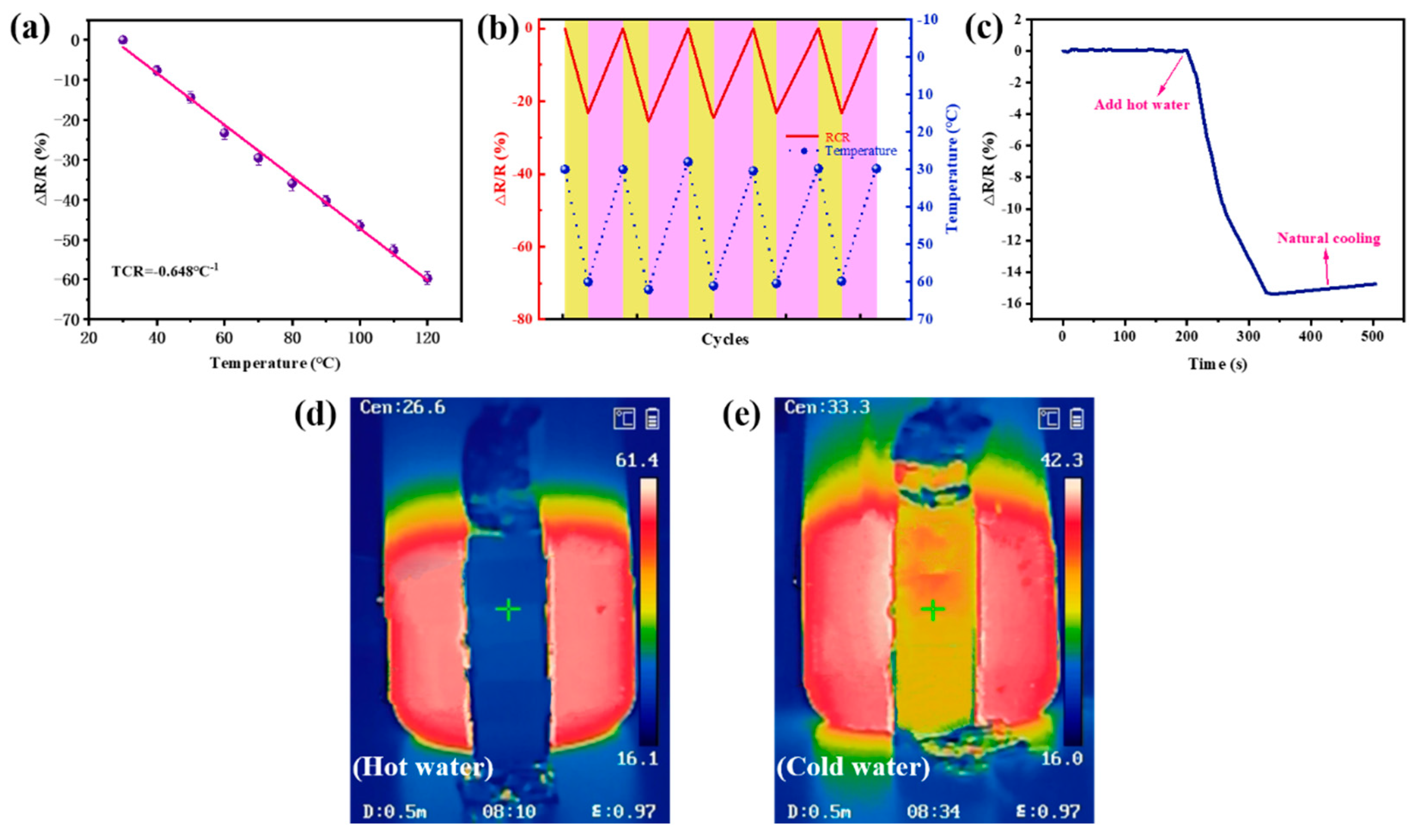

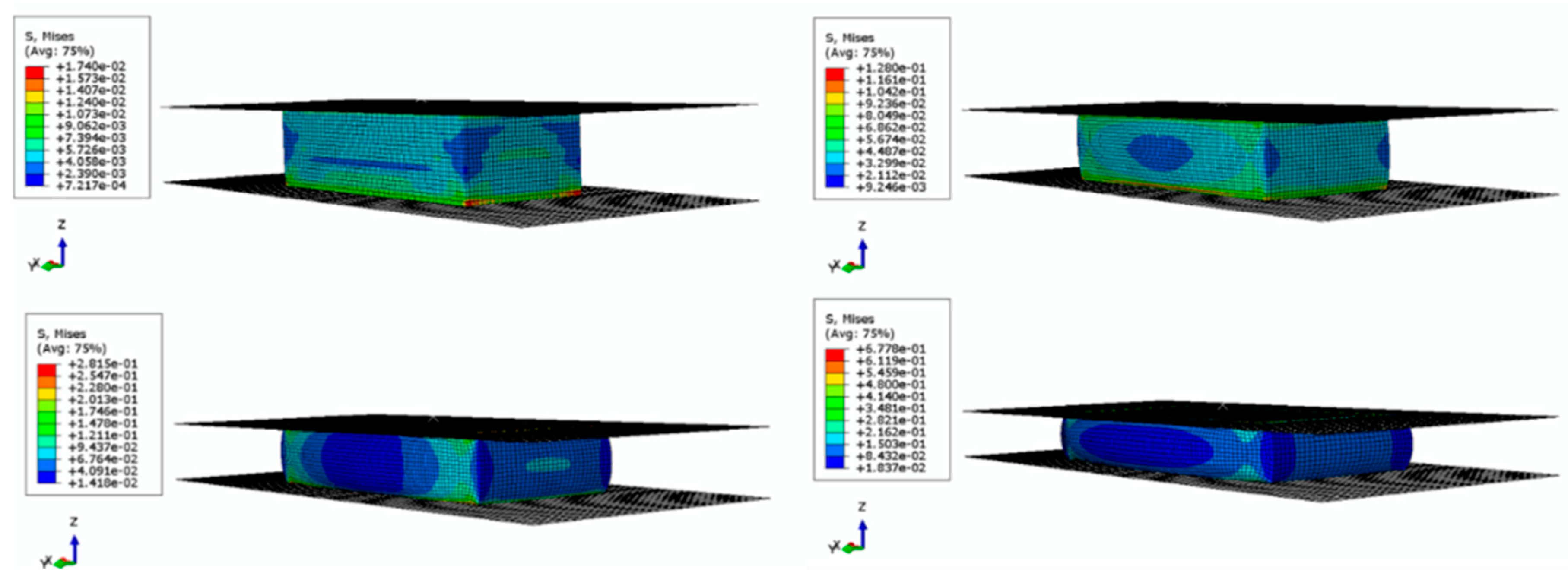
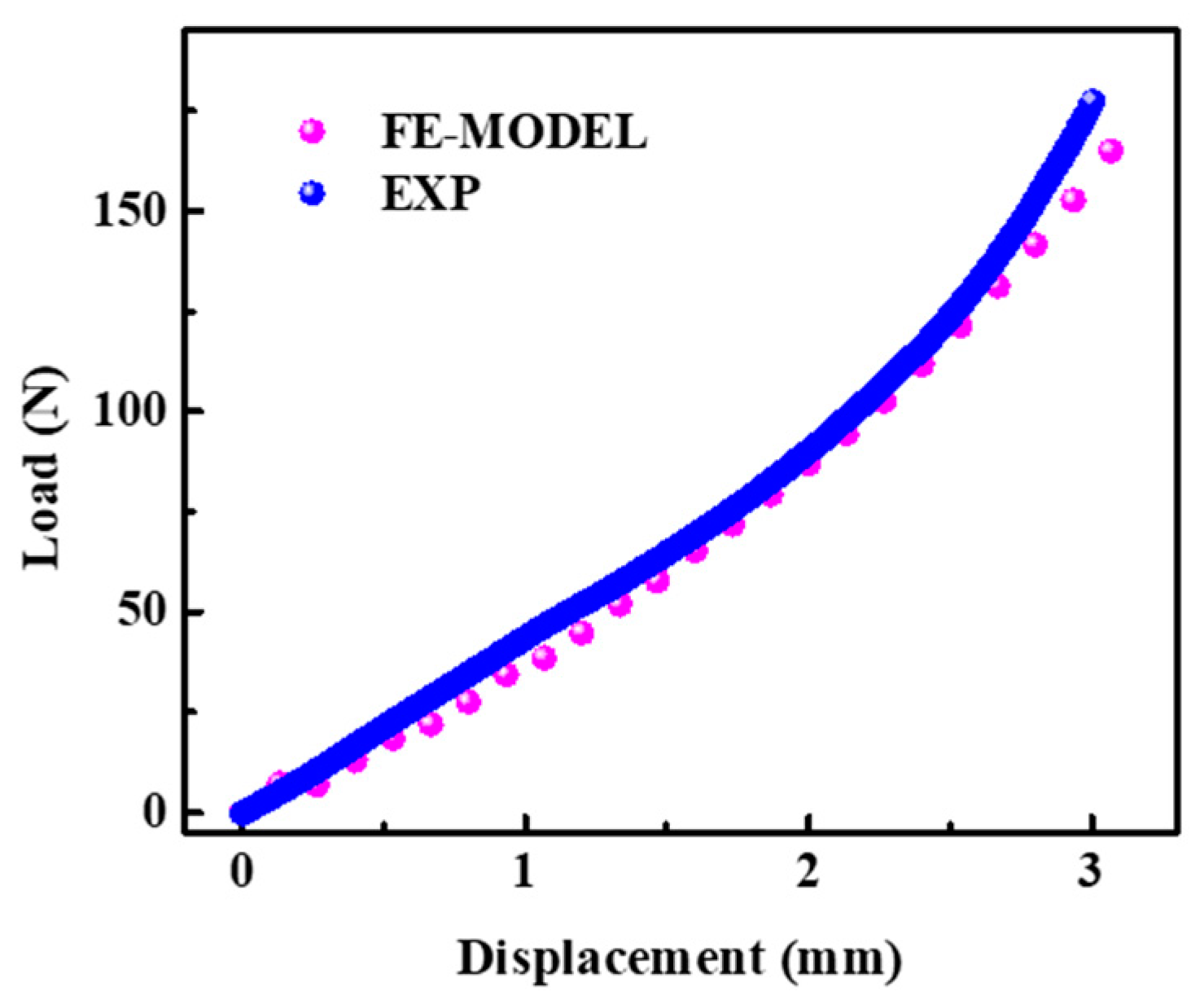


| Materials | Sensitivity | Work Range | Response Time | Reference |
|---|---|---|---|---|
| Flat knitting spacer fabric/Conductive cloth tape | 0.009 kPa−1 | 0~100 kPa | 150 ms | [35] |
| Mxene | GF = 6.02 | 0~20% | None | [36] |
| TFEA/AAm | 0.0059 kPa−1 (1~10 kPa), 0.0026 kPa−1 (10~100 kPa) | 1~100 kPa | 200 ms | [37] |
| Conductive cloth tape/Porous PDMS | 0.023 kPa−1 | 0~200 kPa | 155 ms | [38] |
| Electrode plates/Porous PDMS | 0.0107 kPa−1 | 0~12 kPa | None | [39] |
| Graphene | GF = 17.71 (0%~55%) 0.125 kPa−1 (0~15 kPa) | 0~55% 0~335 kPa | 92 ms | This work |
Disclaimer/Publisher’s Note: The statements, opinions and data contained in all publications are solely those of the individual author(s) and contributor(s) and not of MDPI and/or the editor(s). MDPI and/or the editor(s) disclaim responsibility for any injury to people or property resulting from any ideas, methods, instructions or products referred to in the content. |
© 2024 by the authors. Licensee MDPI, Basel, Switzerland. This article is an open access article distributed under the terms and conditions of the Creative Commons Attribution (CC BY) license (https://creativecommons.org/licenses/by/4.0/).
Share and Cite
Wang, S.; Pu, J.; Xu, S.; Tian, Y.; Shu, Q.; Zou, R.; Zhang, T. Flexible and Multifunctional Composites with Highly Strain Sensing and Impact Resistance Properties. Polymers 2024, 16, 1544. https://doi.org/10.3390/polym16111544
Wang S, Pu J, Xu S, Tian Y, Shu Q, Zou R, Zhang T. Flexible and Multifunctional Composites with Highly Strain Sensing and Impact Resistance Properties. Polymers. 2024; 16(11):1544. https://doi.org/10.3390/polym16111544
Chicago/Turabian StyleWang, Shu, Jianyu Pu, Shuquan Xu, Yuanhao Tian, Qian Shu, Rui Zou, and Tonghua Zhang. 2024. "Flexible and Multifunctional Composites with Highly Strain Sensing and Impact Resistance Properties" Polymers 16, no. 11: 1544. https://doi.org/10.3390/polym16111544
APA StyleWang, S., Pu, J., Xu, S., Tian, Y., Shu, Q., Zou, R., & Zhang, T. (2024). Flexible and Multifunctional Composites with Highly Strain Sensing and Impact Resistance Properties. Polymers, 16(11), 1544. https://doi.org/10.3390/polym16111544







